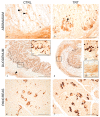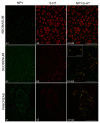Distinct Pattern of NPY in Gastro-Entero-Pancreatic System of Goat Kids Fed with a New Standardized Red Orange and Lemon Extract (RLE)
- PMID: 33572145
- PMCID: PMC7914828
- DOI: 10.3390/ani11020449
Distinct Pattern of NPY in Gastro-Entero-Pancreatic System of Goat Kids Fed with a New Standardized Red Orange and Lemon Extract (RLE)
Abstract
The use of natural compounds as feed additive is also increasing in farm animals, thanks to the beneficial effect on both animals and consumers health. Here, we questioned whether natural extracts, such as red orange and lemon extract (RLE) rich in flavanones, anthocyanins, and other polyphenols, used as feed additives could display an effect on the neuropeptide Y (NPY) in the gastro-entero-pancreatic tract of goat kids. NPY is one of the most abundant neuropeptides in mammals, known for its orexigenic role although it is involved in many central and peripheral functions. We carried out immunohistochemical analyses on samples of abomasum, duodenum and pancreas collected from two experimental groups: one fed with standard diet and one with standard diet + RLE. For the first time we document NPY distribution in the abomasum, duodenum and pancreas of goats and observe the highest number of NPY positive cells in neuroendocrine cells of duodenum. Remarkably, upon RLE feed supplementation, NPY immunoreactive cells increased significantly in abomasal epithelium and pancreatic islets but not in duodenum, likely due to pH variation of abomasum and duodenum. Our observations represent a baseline for future studies on the interaction between neuropeptides and polyphenols, used as feed additive.
Keywords: feed additive; gastro-intestinal apparatus; goats; natural compound; neuropeptides; polyphenols; small ruminants.
Conflict of interest statement
The authors declare no conflict of interest.
Figures




References
-
- Hassimotto N.M., Moreira V., do Nascimento N.G., Souto P.C., Teixeira C., Lajolo F.M. Inhibition of carrageenan-induced acute inflammation in mice by oral administration of anthocyanin mixture from wild mulberry and cyanidin-3-glucoside. Biomed. Res. Int. 2013;2013:146716. doi: 10.1155/2013/146716. - DOI - PMC - PubMed
LinkOut - more resources
Full Text Sources
Other Literature Sources
Miscellaneous
